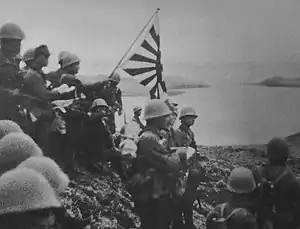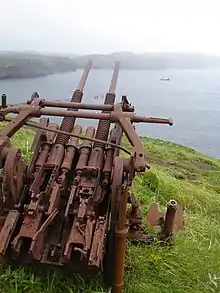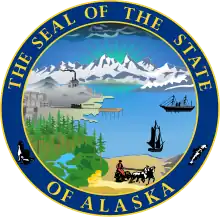Japanese occupation of Kiska
The Japanese occupation of Kiska took place between 6 June 1942 and 28 July 1943 during the Aleutian Islands campaign of the American Theater and the Pacific Theater of World War II. The Japanese occupied Kiska and nearby Attu Island in order to protect the northern flank of the Japanese Empire. Along with the Attu landing the next day, it was the first time that the United States was occupied by a foreign power since the War of 1812, and was one of the two invasions of the United States during World War II.
| Japanese occupation of Kiska | |||||||||
|---|---|---|---|---|---|---|---|---|---|
| Part of the American Theater and the Pacific Theater of World War II | |||||||||
 Japanese troops raise the Imperial battle flag on Kiska after landing on 6 June 1942. | |||||||||
| |||||||||
| Belligerents | |||||||||
| Commanders and leaders | |||||||||
|
Lt. Mulls (Not present during initial landing)[1] |
| ||||||||
| Strength | |||||||||
|
10-man weather station 1-6 dogs 3 aircraft[1] |
+500 Special Naval Landing Forces (Initial force) 5,183-5,400 civilians and soldiers (Occupation)[2] | ||||||||
| Casualties and losses | |||||||||
|
2 killed 7 captured 1 escaped (later surrendered) | No casualties during initial capture, or during occupation/withdraw. | ||||||||
Background
For the Imperial Japanese Navy, the North Pacific had a vast frontage from the Kuril Islands to Minami-Tori-shima, and patrols in this vast sea area with few islands had not been easy. The Fifth Fleet, which conducted patrols of the ocean off east of Japan, had begun to advocate since the end of January 1942 that the Imperial Navy occupy the western Aleutian Islands and advance the patrol line.[3] In addition, the air raid on Minami-Tori-shima by the US in March 1942 raised concerns about the North Pacific Ocean throughout the Japanese military.[4]
Operation AL
Although it is not clear how the Navy General Staff requested the Combined Fleet Command to plan the Aleutian Operation ( Operation AL) to occupy Attu and Kiska Islands,[4] the Navy General Staff seemed to have acknowledged the necessity of Operation AL in response to the proposition of the Fifth Fleet when considering the attempt to overtake Midway (Operation MI).
The plan of Operation AL was consulted with the Imperial General Headquarters army section on 15 April. In early June, the navy would attack Dutch Harbor and Adak Island, and occupy Kiska Island and Attu Island. The Imperial Japanese Army was reluctant to occupy the Aleutian Islands and responded to the navy on 16 April that they would not dispatch troops to the operation.[5] However, the Doolittle Raid on Japan from the North Pacific on 18 April had a great influence on Operation AL. After the air raids on Japan by the Doolittle bombers, the army acknowledged the need to set up patrol bases on the western Aleutian Islands and agreed on 21 April to dispatch troops.[6]
The Navy General Staff promoted Operation MI and Operation AL with the primary purpose of advancing the bases for patrol line, and the Combined Fleet Command also followed it.[7] In other words, the purpose of Operation AL was to build a patrol network in the North Pacific by establishing bases on Midway, Attu, and Kiska to monitor attacks on Japan mainland by US task forces. At the same time, it was intended to prevent advances of US air bases.
Eventually, it was determined that the Imperial Army would invade Attu Island and the Imperial Navy (Navy Maizuru Third Special Naval Landing Force) would invade Kiska Island. The army established the North Sea Detachment (Hokkai-shitai) on 5 May, headed by Major Matsutoshi Hozumi and consisting of approximately 1,000 men.[8]
The order of operation was announced on 5 May.[9] Hozumi was tasked to secure or destroy key points in the western part of the Aleutian Islands, and to make enemy mobility and air power advance in this area difficult. The finalized plan was to destroy Adak's military facilities and then withdraw. Next, the army troops were to invade Attu while the navy invaded Kiska.
Prior to the landings, air raids from carriers were to destroy the air force at Dutch Harbor.
Occupation
Initially, the only American military presence on Kiska was a 12-man United States Navy weather station—two of whom were not present during the invasion—and a dog named Explosion.[10][1] The Japanese stormed the station, killing two Americans and capturing seven. After realizing that Chief Petty Officer William C. House had escaped, a search was launched by the occupying forces. The search ended in vain, with House surrendering some 50 days after the initial seizure of the weather station, having been unable to cope with the freezing conditions and starvation. After 50 days of eating only plants and worms, he weighed just 80 pounds.[10][11] Beforehand, the prisoners of war had been sent to Japan.
The attack on Pearl Harbor and beginning of the Pacific Theater in World War II, coupled with Japanese threats to mainland Alaska along with the rest of the United States West Coast, had already made the construction of a defense access highway to Alaska a priority. On 6 February 1942, the construction of the Alaska Highway was approved by the US Army and the project received the authorization from Congress and President Franklin D. Roosevelt to proceed five days later.
Reacting to the Japanese occupation, American and Allied forces waged a continuous air bombardment campaign against the Japanese forces on Kiska. Also, US Navy warships blockaded and periodically bombarded the island. Several Japanese warships, transport ships, and submarines attempting to travel to Kiska or Attu were sunk or damaged by the blockading forces.
Evacuation

In May 1943, US forces landed on Attu in Operation Landcrab and subsequently destroyed the Japanese garrison there. In response, the Imperial Japanese Navy successfully evacuated the island of Kiska, ending the Japanese presence in the Aleutian Islands.
On 29 July 1943 Rear Admiral Kimura Masatomi, commanding two light cruisers and ten destroyers, slipped through the American blockade under the cover of fog and rescued 5,193 men. The operation was run by light cruisers Abukuma and Kiso; and destroyers Yūgumo, Kazagumo, Usugumo, Asagumo, Akigumo and Hibiki. The destroyers Hatsushimo, Naganami, Shimakaze and Samidare gave cover to the operation.[12] The successful evacuation of the garrison was subject of 1965 Seiji Maruyama's movie "Taiheiyô kiseki no sakusen: Kisuka" (literally, "Miracle Operation in the Pacific: Kiska").[13]
Not completely sure that the Japanese were gone, the Americans and Canadians executed an unopposed landing on Kiska on 15 August, securing the island and ending the Aleutian Islands campaign. After the landing, the soldiers were greeted by a group of dogs which had been left behind. Among them was Explosion, who had been cared for by the Japanese.
Even though the island was unoccupied, the Allied forces still suffered casualties. There was a thick fog which was in part responsible for friendly fire incidents, which killed 24 soldiers. Four more were killed by booby traps the Japanese had left behind. The ship Abner Read also struck a naval mine which killed 71. [14]
Naval operations
On 19 June 1942, American aircraft attacked and sank the Japanese oiler Nissan Maru in Kiska Harbor, and on 30 June American naval forces bombarded the island. The submarine USS Growler attacked and sank one Japanese destroyer 7 mi (6.1 nmi; 11 km) east of Kiska Harbor on 5 July; two other destroyers were heavily damaged. Over 200 Japanese sailors were killed or wounded while the Americans sustained no losses. It became the single bloodiest engagement during the operations on and around Kiska. USS Grunion was attacked by three Japanese submarine chasers while patrolling Kiska Harbor on 15 July. In response, she fired on and sank two of the ships and damaged the third. Grunion was lost a few weeks later off Kiska on 30 July with all hands; she is suspected of being sunk after one of her own torpedoes circled back when she attacked the Kano Maru.
On 8 August, the Japanese cargo ship Kano Maru was sunk at Kiska Harbor by PBY Catalinas. Days before, the cargo ship was damaged by one of Grunion's torpedoes. Troopship Nozima Maru was also bombed and sunk in Kiska Harbor on 15 September. On 5 October, the Japanese steamer Borneo Maru was sunk at Gertrude Cove, and on 17 October the destroyer Oboro was sunk by American aircraft. Ro-65 sank off Kiska on 4 November, Montreal Maru on 6 January 1943, and Uragio Maru on 4 April. I-7 was grounded and abandoned by her crew on 23 June while assisting in removing Kiska's garrison. She was chased onto the rocks by USS Monaghan.
References
Notes
- "Caption for (WX16-Sept.22) Navy's Kiska Weather Unit Held Prisoners By Japs". Archived from the original on 2015-08-25. Retrieved 2015-04-28.
- PacificWrecks.com. "Pacific Wrecks". Retrieved 25 July 2018.
- (Office of war history 1968a, p. 206)
- (Office of war history 1968a, p. 206)
- (Office of war history 1968a, p. 208)
- (Office of war history 1968a, p. 209)
- (Kakizaki 1980, p. 433)
- (Office of war history 1968b, p. 98)
- (Office of war history 1968a, pp. 209–211)
- "Japanese Occupation Site at Kiska Island". Retrieved 25 July 2018.
- http://www.pacificwrecks.com/provinces/alaska_kiska
- "Nihon Kaigun". www.combinedfleet.com. Retrieved 2022-02-21.
- Maruyama, Seiji (1965-07-04), Taiheiyô kiseki no sakusen: Kisuka (Drama, History, War), Toho Company, retrieved 2022-02-21
- "Archived copy" (PDF). Archived from the original (PDF) on 2016-08-03. Retrieved 2016-05-12.
{{cite web}}: CS1 maint: archived copy as title (link)
Bibliography
- Cloe, John Haile (1990). The Aleutian Warriors: A History of the 11th Air Force and Fleet Air Wing 4. Missoula, Montana: Pictorial Histories Publishing Co. and Anchorage Chapter – Air Force Association. ISBN 0-929521-35-8. OCLC 25370916.
- Dickrell, Jeff (2001). Center of the Storm: The Bombing of Dutch Harbor and the Experience of Patrol Wing Four in the Aleutians, Summer 1942. Missoula, Montana: Pictorial Histories Publishing Co., Inc. ISBN 1-57510-092-4. OCLC 50242148.
- Feinberg, Leonard (1992). Where the Williwaw Blows: The Aleutian Islands-World War II. Pilgrims' Process. ISBN 0-9710609-8-3. OCLC 57146667.
- Garfield, Brian (1995) [1969]. The Thousand-Mile War: World War II in Alaska and the Aleutians. Fairbanks: University of Alaska Press. ISBN 0-912006-83-8. OCLC 33358488.
- Goldstein, Donald M.; Katherine V. Dillon (1992). The Williwaw War: The Arkansas National Guard in the Aleutians in World War. Fayetteville: University of Arkansas Press. ISBN 1-55728-242-0. OCLC 24912734.
- Hays, Otis (2004). Alaska's Hidden Wars: Secret Campaigns on the North Pacific Rim. University of Alaska Press. ISBN 1-889963-64-X.
- Lorelli, John A. (1984). The Battle of the Komandorski Islands. Annapolis: United States Naval Institute. ISBN 0-87021-093-9. OCLC 10824413.
- Morison, Samuel Eliot (2001) [1951]. Aleutians, Gilberts and Marshalls, June 1942-April 1944, vol. 7 of History of United States Naval Operations in World War II. Champaign: University of Illinois Press. ISBN 0-316-58305-7. OCLC 7288530.
- Parshall, Jonathan; Tully, Anthony (2005). Shattered Sword: The Untold Story of the Battle of Midway. Dulles, Virginia: Potomac Books. ISBN 1-57488-923-0. OCLC 60373935.
- Perras, Galen Roger (2003). Stepping Stones to Nowhere, The Aleutian Islands, Alaska, and American Military Strategy, 1867 - 1945. Vancouver: University of British Columbia Press. ISBN 1-59114-836-7. OCLC 53015264.
- Urwin, Gregory J. W. (2000). The Capture of Attu: A World War II Battle as Told by the Men Who Fought There. Bison Books. ISBN 0-8032-9557-X.
- Wetterhahn, Ralph (2004). The Last Flight of Bomber 31: Harrowing Tales of American and Japanese Pilots Who Fought World War II's Arctic Air Campaign. Da Capo Press. ISBN 0-7867-1360-7.
- MacGriggle, George L. Aleutian Islands. The U.S. Army Campaigns of World War II. United States Army Center of Military History. CMH Pub 72-6. Archived from the original on 2014-03-17. Retrieved 2010-08-05.
- Office of war history (1968a). Senshi-sosho [the Japanese War History Series Vol. 29. "Navy operations in the Northeastern"] (in Japanese). Asagumo Newspaper Publishing.
- Office of war history (1968b). Senshi-sosho [The Japanese War History Series Vol. 21. "Army operations in the Northeastern <1> Attu’s Gyokusai"] (in Japanese). Asagumo Newspaper Publishing.
- Kakizaki, Seiichi (1980). Private view on the Kiska invasion operation, in Military history of Kiska (edited by Kiska-kai) (in Japanese). Hara Shobou.
External links
- Logistics Problems on Attu by Robert E. Burks.
- Aleutian Islands Chronology
- Aleutian Islands War
- Red White Black & Blue - feature documentary about The Battle of Attu in the Aleutians during World War II
- PBS Independent Lens presentation of Red White Black & Blue Archived 2010-07-27 at the Wayback Machine - The Making Of and other resources
- Soldiers of the 184th Infantry, 7th ID in the Pacific, 1943-1945
- 3. Aleutian Operation (1) Attacks on Dutch Harbor "Battles around the Aleutian Islands from Japanese side views"

